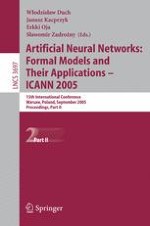This volume is the first part of the two-volume proceedings of the International C- ference on Artificial Neural Networks (ICANN 2005), held on September 11–15, 2005 in Warsaw, Poland, with several accompanying workshops held on September 15, 2005 at the Nicolaus Copernicus University, Toru , Poland. The ICANN conference is an annual meeting organized by the European Neural Network Society in cooperation with the International Neural Network Society, the Japanese Neural Network Society, and the IEEE Computational Intelligence Society. It is the premier European event covering all topics concerned with neural networks and related areas. The ICANN series of conferences was initiated in 1991 and soon became the major European gathering for experts in those fields. In 2005 the ICANN conference was organized by the Systems Research Institute, Polish Academy of Sciences, Warsaw, Poland, and the Nicolaus Copernicus Univ- sity, Toru , Poland. From over 600 papers submitted to the regular sessions and some 10 special c- ference sessions, the International Program Committee selected – after a thorough peer-review process – about 270 papers for publication. The large number of papers accepted is certainly a proof of the vitality and attractiveness of the field of artificial neural networks, but it also shows a strong interest in the ICANN conferences.
